Hanging on a rack in a local department store, a sweater can be seen as nothing more than an innocuous piece of everyday clothing. But a sweater worn by Aileen Wuornos gives an insight into the psychological and physical torture she put herself through while on death row. As well as believing the guards were going to steal her eyeballs postmortem, Wuornos was convinced that they were perpetually trying to make her sick by keeping her cell exceptionally cold (an accusation the guards always denied). She wore the same sweater almost every day to try and stay warm.
Male inmate clothing, female inmate clothing, and female clothing worn by male inmates. The collection of Brandy Williamson focuses on garments worn by notorious killers, such as the cap of a murderous necrophiliac, the boxer shorts of a serial rapist who killed five of his victims, and the sweatpants worn by Charles Manson while incarcerated at California State Prison, Corcoran. Nothing could be considered more “everyday” than a pair of sneakers—unless they belonged to killer Joseph Druce, in which case they represent 48 years of pain, anger, and ultimately revenge.
Understanding the desire to possess an article once owned by a serial killer is complex. Many experts in the field of psychology say the seeking out of clothing worn by deviants of society sends us further down a labyrinth of potential psychological motivations. Brandy explains her own interest: “I don’t collect it to glorify killers or out of some sick fascination with murder and death. I do find it fascinating that I can physically connect myself to some of the worst people on the planet by holding a pair of underwear that was worn by someone on death row.
It is an interesting experience. And to be honest, some of the artwork to come from these folks is really good! People like Glen Rogers, Chuck Reinhardt, Keith Jesperson … they’re all pretty talented fellas.”
“I don’t care for school-shooter items, although I’ve got a few Columbine shirts. Lately, I’ve been more interested in finding more Jack Kevorkian items. I own one of his artwork prints, but I would love to have an original. My holy grail would probably be the original oil on canvas, ‘Nearer My God to Thee,’ by Kevorkian. Although, I’d settle for just a signed print!”
The collection of Brandy Williamson – Photos by Kyle Jarrad
Although women make up a large part of the true crime fan base, the field of true crime collecting is disproportionately male dominated. Brandy is one of the few female true crime collectors, and although she has not been in the game long, she has already curated an impressive collection of dark artifacts. “Although I’m new to true crime, I have been collecting oddities for years. Taxidermy, skulls, medical antiques, stuff like that, and it was here, in the oddities community, that I became aware of a market for true crime items.”
As a child Brandy had a fascination with true crime and by the time she reached high school she was ready to take the plunge. Fascinated by the Tate–LaBianca murders, she wanted to write to the imprisoned Charles Manson. However, her mother feared that someone from the Family would come after her and forbade her from reaching out. Brandy settled for writing her senior leadership essay on Manson.
“The first item I ever purchased was artwork by Charles Manson. Since then, I have acquired some other great pieces, with a concentration on artwork and inmate-worn clothing.
In fact, if I had to choose my favorite true crime possession, it would be a toss-up between my Charles Manson sweatpants and my Aileen Wuornos underwear and bra set.”
Sunset Strip Killers
Doug Clark was one half of the duo known as the Sunset Strip Killers. Between June 1 and August 1980, Clark and his partner Carol Bundy were allegedly involved in at least seven incidents of rape, murder, decapitation, and necrophilia. Clark was convicted and sentenced to death in 1983. However, many believe that he was innocent and did not get a fair trial.
 1.1 A hat owned by Doug Clark while serving his sentence on death row, where, as of 2021, he remains in California’s notorious San Quentin State Prison.
1.1 A hat owned by Doug Clark while serving his sentence on death row, where, as of 2021, he remains in California’s notorious San Quentin State Prison.
Manson Style
In December 1969, Charles Manson and four other Family members were indicted on murder and conspiracy charges in the Tate–La Bianca killings. For the next 225 days, Manson and the Family appeared almost daily on the front page of newspapers and magazines, and on countless TV news reports.
Criminologists and psychologists have credited Manson’s hairstyle and the clothes he wore as being influential in his ability to lull his followers into a state of complacency: he looked and dressed like them, and his hair and beard resembled that of Jesus (symbolizing love and peace). His style also made people view him as a man of power and intimidation, often combining flower power clothes with army fatigues and camouflage gear.
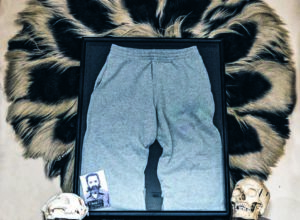 2.1 A pair of sweatpants worn by Charles Manson, given to a pen pal while Manson was “in the hole” for a rule violation.
2.1 A pair of sweatpants worn by Charles Manson, given to a pen pal while Manson was “in the hole” for a rule violation.
Seven Counts of Murder
Todd Kohlhepp began his killing in 2003, when he was 42 years old, but his troubles began much earlier, and he was described as a troublesome child as early as nursery school.
In 1987 Kohlhepp was sentenced to 15 years for kidnapping and raping a 15-year-old girl. While in prison he studied for an undergraduate degree, and on release in 2001 he started and developed a successful real-estate business. Nevertheless, Kohlhepp gained a reputation for being abusive and creepy. Between 2003 and 2016 he killed seven men and women. On May 26, 2017, he pleaded guilty to the seven counts of murder and was sentenced to seven consecutive life sentences without the possibility of parole.
 3.1 Gun case, blanket, and gloves purchased at the estate auction of Todd Kohlhepp. A first aid kit and zip ties were found inside the gun case.
3.1 Gun case, blanket, and gloves purchased at the estate auction of Todd Kohlhepp. A first aid kit and zip ties were found inside the gun case.
Heel to the Head Renders Them Dead
As a child, life was a nightmare for Joseph Druce. Allegedly, he was severely beaten by his father and from the age of eight sexually abused by three men, including a neighbor and a man with a religious affiliation.
While hitchhiking in 1988, Druce was picked up by the 51-year-old George Rollo. According to Druce, Rollo tried to rub his groin. Druce reacted violently, beating Rollo and throwing him in the trunk of the car, later strangling him. Druce was quickly arrested and held on a first-degree murder charge. The defense presented a case highlighting that Druce had been in psychiatric treatment since he was five years old. This did little to dissuade the judge and jury, and he was sentenced to life in prison.
On the morning of August 23, 2003, as inmates were returning from lunch in the protective custody unit at Souza-Baranowski Correctional Center, Druce allegedly slipped into the cell of John J. Geoghan, a former Roman Catholic priest and convicted pedophile serving a ten-year sentence. Druce bound, strangled, and stomped Geoghan to death.
The Living Dead Girl
On March 30, 1996, 20-year-old Christa Pike received the dubious honor of being one of the youngest women to be sentenced to death in the United States. Aged 18, while undertaking a vocational training program at the University of Tennessee, she murdered classmate Colleen Slemmer, who she thought was trying to steal her boyfriend. She tortured the girl with a box cutter, carving images into her chest before smashing her head in with a slab of asphalt. The asphalt shattered the victim’s skull.
Pike kept a fragment of skull and began showing it to people around campus. Within 36 hours she and her two accomplices were arrested. Only Pike received a death sentence for the crime, and she is presently awaiting execution on death row in Tennessee Prison for Women.
 5.1 A shirt owned and signed by Christa Pike while on death row. The shirt was sent to a pen pal.
5.1 A shirt owned and signed by Christa Pike while on death row. The shirt was sent to a pen pal.
Cross-dressing Killer
“I buried one girl by the rocks in front of the castle,” Hadden Clark admitted during a phone interview from the Maryland prison where he is serving his life sentence. However, it wasn’t Clark speaking about his sordid past, but rather his alter ego, “Kristen Bluefin.” It was under the persona of Bluefin that Clark confessed to a fellow inmate (who he believed was Jesus Christ) that he had killed at least a dozen women or girls.
In June 1993 Clark pleaded guilty to second-degree murder and was sentenced to 30 years in prison. In 1999 he was convicted of murdering a second person, adding another 30 years to his sentence.
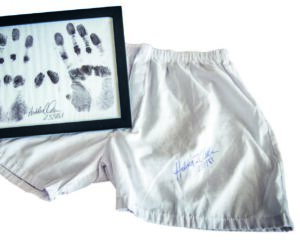 6.1 Hadden Clark’s handprints, along with a pair of boxer shorts worn and signed by Clark and given to one of his pen pals to be sold for commissary money.
6.1 Hadden Clark’s handprints, along with a pair of boxer shorts worn and signed by Clark and given to one of his pen pals to be sold for commissary money.
 6.2 These ladies’ panties were purchased for Clark by the FBI for his trip to Cape Cod in 2000 to search for one of the bodies he had hidden. Clark insisted his alter ego, Kristen Bluefin, go on the search, hence the FBI’s purchase of underwear, a skirt, and a blouse for him to wear.
6.2 These ladies’ panties were purchased for Clark by the FBI for his trip to Cape Cod in 2000 to search for one of the bodies he had hidden. Clark insisted his alter ego, Kristen Bluefin, go on the search, hence the FBI’s purchase of underwear, a skirt, and a blouse for him to wear.
Steal Her Eyeballs
Using the Psychopathy Checklist, Aileen Wuornos was found to have a psychopathic personality with a PCL-R score of 32, the cutoff score for psychopathy in the United States being 30.
While Aileen was serving time on death row after confessing to the murder of seven men, her psychotic behavior and paranoia continued. Aileen was convinced guards would steal her belongings after she was executed. She even thought they would steal her eyeballs. Aileen wanted her childhood friend, Dawn Botkins, to have all her belongings after execution, and asked Dawn to view her body as soon as possible to make sure her eyes were still there.
 7.1 A necklace worn by Aileen while on death row, and given to Dawn when Wuornos was executed. Dawn kept this hidden until Brandy purchased it from her in 2019. Also shown are Aileen’s watch, a childhood photo, prison snapshots and a list of funeral songs she compiled.
7.1 A necklace worn by Aileen while on death row, and given to Dawn when Wuornos was executed. Dawn kept this hidden until Brandy purchased it from her in 2019. Also shown are Aileen’s watch, a childhood photo, prison snapshots and a list of funeral songs she compiled.
 7.2 A complete set of religious comics that Aileen owned. Many of them have her notes written in the margins.
7.2 A complete set of religious comics that Aileen owned. Many of them have her notes written in the margins.
 7.3 A sweater owned by Aileen Wuornos on death row. Aileen was always cold and wore this red sweater almost every day. Dawn said that Aileen thought the guards were tormenting her and would keep her cell colder than anyone else’s.
7.3 A sweater owned by Aileen Wuornos on death row. Aileen was always cold and wore this red sweater almost every day. Dawn said that Aileen thought the guards were tormenting her and would keep her cell colder than anyone else’s.
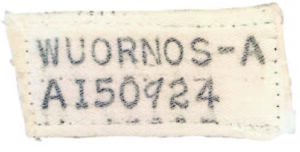 7.4 A tag from Wuornos’s death row jumpsuit. Aileen mailed it to Dawn toward the end of her sentence. Dawn said it was one of the most surprising items Aileen ever sent her, and she was amazed it wasn’t found and confiscated.
7.4 A tag from Wuornos’s death row jumpsuit. Aileen mailed it to Dawn toward the end of her sentence. Dawn said it was one of the most surprising items Aileen ever sent her, and she was amazed it wasn’t found and confiscated.
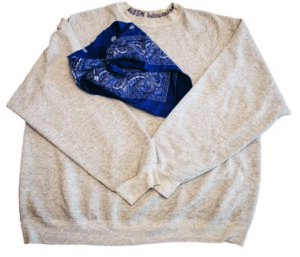 7.5 A sweatshirt and bandanna worn by Wuornos while on death row. The bandanna is still tied in the same spot as when Dawn received it after Aileen’s execution.
7.5 A sweatshirt and bandanna worn by Wuornos while on death row. The bandanna is still tied in the same spot as when Dawn received it after Aileen’s execution.
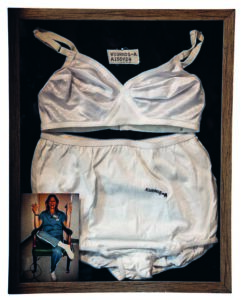 7.6 One of the last sets of underwear owned by Aileen Wuornos. She made sure to leave every personal belonging to Dawn, and told Dawn to sell the underwear when she needed to make a mortgage payment.
7.6 One of the last sets of underwear owned by Aileen Wuornos. She made sure to leave every personal belonging to Dawn, and told Dawn to sell the underwear when she needed to make a mortgage payment.
Remorseless Predator
Phillip Carl Jablonski was born in Joshua Tree, California, in 1946. He left in 1966 to join the Army and was discharged on medical grounds in 1969, having been diagnosed with a schizophrenic illness. On his return to the United States he ended up in Texas, and it was there that Jablonski began his career as a serial rapist and ultimately a serial killer.
By April 1991, he had raped countless women and killed five, including the rape, murder, and mutilation of a 38-year-old mother of two teenage girls. The mother was found lying dead and naked in the Colorado desert with the words “I Love Jesus” carved into her back and her eyes and ears removed.
That same year Jablonski was arrested, found guilty of five murders, including those of two of his ex-wives and his former mother-in-law, and sentenced to death. He died in his cell in San Quentin State Prison on December 27, 2019, at the age of 73.
 8.1 A pair of boxer shorts once owned by Phillip Jablonski while on death row. There are smudges of paint on them, which means he likely made many of his paintings in just his underwear.
8.1 A pair of boxer shorts once owned by Phillip Jablonski while on death row. There are smudges of paint on them, which means he likely made many of his paintings in just his underwear.

















